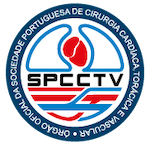Thymoma and myasthenia gravis – an observational study at a tertiary center
DOI:
https://doi.org/10.48729/pjctvs.275Abstract
Introduction: Acquired Myasthenia Gravis (MG) is a rare autoimmune neurological disorder characterized by fluctu- ating paresis of the skeletal muscle due to pathogenic antibodies against the acetylcholine receptor or other elements of the neuromuscular plaque. There is a close relation between MG and thymoma. We aimed to characterize a population of patients with Myasthenia Gravis associated thymoma (MGAT).
Methods: Retrospective and longitudinal study in all patients with MGAT observed at a tertiary center between 2009 and 2020. We assessed epidemiological, clinical, laboratory and therapeutic features of both MG and thymoma.
Results: We found 18 patients with an average age of 53 ± 16.2, 13 of them females. Most patients (n=15) presented the generalized MG form. Most frequent Masaoka staging was II (n=7). Regarding the WHO histopathological classification of thymoma, most patients (n=11) presented with type B2 or B3. Thirteen patients underwent extended thymectomy (12 by median sternotomy and 1 by VATS). Of the remaining 5 patients, 4 of them underwent a CT scan guided biopsy, and 1 patient did not accept further work-up. Seven patients were classified as R0 for surgical resection margins and only one of them had recurrence of thymoma. Besides surgery, oncological treatment included radiotherapy and chemotherapy. Five patients expe- rienced a myasthenic crisis during the course of the disease. Three deaths occurred in the studied population.
Conclusions: This study helped to pinpoint important aspects concerning therapeutic orientation of MGAT patients, such as the clinical impact of thymectomy in the course of MGAT, the oncological prognostic value of surgical resection mar- gins, and the importance of preoperative intravenous immunoglobulin. Management of MGAT patients is only possible with a multidisciplinary approach.
Downloads
References
Gilhus, N.E., Tzartos, S., Evoli, A. et al. Myasthenia gravis. Nat Rev Dis Primers 5, 30, 2019.
Thanvi BR, Lo TCN. Update on myasthenia gravis. Postgraduate Medical Journal 2004;80:690-700.
Aydin, Y. et al. Thymectomy in Myasthenia Gravis. Eurasian J Med 2017; 49: 48-52
Bak, V. et al. Importance of thymectomy and prognostic factors in the complex treatment of myasthenia gravis. Bratisl Med J 2016; 117 (4) 195-200
Chen, P. et al. Pathological findings in Myasthenia Gravis patients with Thymic Hyperplasia and Thymoma. Pathol. Oncol. Res 2017 DOI 10.1007/s12253-017-0213-7
Zhang, Z. et al. Myasthenia gravis in patients with thymoma affects survival rate following extended thymectomy. Oncology Letters 2016 11: 4177-4182
Marx A, Chan JK, Coindre JM, et al. The 2015 World Health Organization Classification of Tumors of the Thymus: Continuity and Changes. J Thorac Oncol. 2015;10(10):1383-1395. doi:10.1097/JTO.0000000000000654
Masaoka A. Staging system of thymoma. J Thorac Oncol. 2010 Oct;5(10 Suppl 4):S304-12. doi: 10.1097/JTO.0b013e- 3181f20c05. PMID: 20859124.
Amin, M.B., Edge, S., Greene, F., Byrd, D.R., Brookland, R.K., Washington, M.K., Gershenwald, J.E., Compton, C.C., Hess, K.R., Sullivan, D.C., Jessup, J.M., Brierley, J.D., Gas- par, L.E., Schilsky, R.L., Balch, C.M., Winchester, D.P., Asare, E.A., Madera, M., Gress, D.M., Meyer, L.R. (Eds.). AJCC Cancer Staging Manual, 8th edition. 2017.
A. Jaretzki, R.J. Barohn, R.M. Ernstoff, H.J. Kaminski, J.C. Keesey, A.S. Penn, D.B. Sanders, Task Force of the Medical Scientific Advisory Board of the Myasthenia Gravis Foundation of America. Myasthenia gravis Recommendations for clinical research standards. Neurology Jul 2000, 55 (1) 16-23; DOI: 10.1212/WNL.55.1.16
Gilhus, N. E.,Verschuuren, J. J. Myasthenia gravis: subgroup classification and therapeutic strategies. Lancet Neurol 2015; 14: 1023-36
Meriggioli MN, Sanders DB. Muscle autoantibodies in myasthenia gravis: beyond diagnosis?. Expert Rev Clin Immunol. 2012;8(5):427-438. doi:10.1586/eci.12.34
Romi F, Bø L, Skeie GO, Myking A, Aarli JA, Gilhus NE. Titin and ryanodine receptor epitopes are expressed in cortical thymoma along with costimulatory molecules. J Neuroimmunol. 2002 Jul;128(1-2):82-9. doi: 10.1016/s0165-5728(02)00145-5. PMID: 12098514.
Roden, A. C. et al. Modified Masaoka Stage and Size are independent prognostic predictors in Thymoma and Modified Masaoka Stage is superior do histopathologic classifications. J Thorac Oncol. 2015;10: 691-700
Ruffini E, Venuta F. Management of thymic tumors: a European perspective. J Thorac Dis. 2014;6Suppl 2(Suppl 2):S228-S237. doi:10.3978/j.issn.2072-1439.2014.04.19
Guerrera, F. et al. Does the World Health Organization histological classification predict outcomes after thymectomy? Results of a multicentre study on 750 patients. Eur J Cardiothorac Surg 2015;48:48-54
NajibSafieddine, Geoffrey Liu, Kris Cuningham, Tsao Ming, David Hwang, Anthony Brade, Andrea Bezjak, Stefan Fischer, Wei Xu, Sassan Azad, Marcelo Cypel, Gail Darling, KazuYasufuku, Andrew Pierre, Marc de Perrot, Tom Waddell, ShafKeshavjee, Prognostic Factors for Cure, Recurrence and Long-Term Survival After Surgical Resection of Thymoma, Journal of Thoracic Oncology, Volume 9, Issue 7, 2014; Pages 1018-1022, ISSN 1556-0864, https://doi.org/10.1097/JTO.0000000000000215.
Alipour-Faz A, Shojaei M, Peyvandi H, Ramzi D, Oroei M, Ghadiri F, Peyvandi M. A comparison between IVIG and plasma exchange as preparations before thymectomy in myasthenia gravis patients. Acta Neurol Belg. 2017 Mar;117(1):245-249. doi: 10.1007/s13760-016-0689-z. Epub 2016 Aug 16. PMID: 27530310.
Gamez J, Salvadó M, Carmona F, et al. Intravenous immunoglobulin to prevent myasthenic crisis after thymectomy and other procedures can be omitted in patients with well-controlled myasthenia gravis. Ther Ad Neurol Disord. 2019;12:1756286419864497. Published 2019 Jul 17. doi:10.1177/1756286419864497
Aydemir, B. The effect of Myasthenia Gravis as a prognostic factor in thymoma treatment. North Clin Istanb 2016;3(3):194-200
Fujii, Y. The thymus, thymoma and myasthenia gravis. Surg Today 2013; 43: 461–466.






